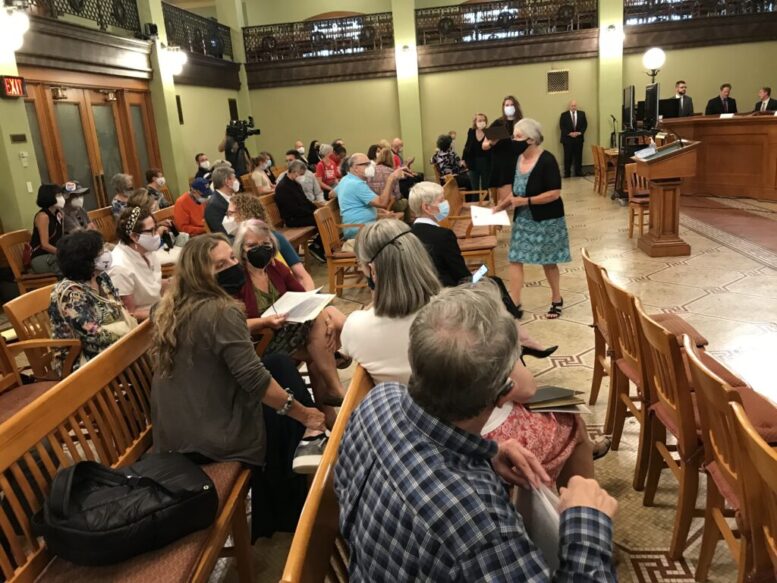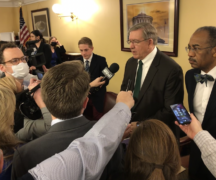BY SUSAN TEBBEN
Two years on from the first attempt at congressional and statehouse redistricting in Ohio, a commission of elected officials is set to begin again next month.
The Ohio Redistricting Commission announced it will meet on Sept. 13 “for organizational purposes and to begin the process of drafting a General Assembly redistricting plan,” according to an official release.
The leaders of the commission are different than the first time around, with Republican state Rep. Jeff LaRe and Democratic Senate Minority Leader Nickie Antonio standing in as co-chairs.
LaRe replaced former House Speaker Bob Cupp, and Antonio is taking over for Democratic state Sen. Vernon Sykes.
Original members include Gov. Mike DeWine, state Secretary of State Frank LaRose and Auditor of State Keith Faber, all Republicans.
Republican Senate Majority Whip Rob McColley replaced Senate President Matt Huffman on the commission, and the only other Democrat on the commission is House Minority Leader Allison Russo, who replaced original member and former state Rep. Emilia Sykes.
New pressures
The commission is set to meet as the state remains under unconstitutional Statehouse maps, rejected five times by a bipartisan majority on the Ohio Supreme Court under its former chief justice, Maureen O’Connor.
O’Connor left the top spot because of age limits, and is now a part of an effort to change the Ohio Constitution yet again when it comes to redistricting process rules, something she pledged to do as she was getting ready to leave office.
The new effort would upend the previous rules, and “replace the current politician-run redistricting process with a citizen-led commission required to create fair state legislative and congressional districts through a more open and independent system,” according to the petition submitted to the Ohio Attorney General on Aug. 14.
Petition-makers have a little more work to do, though, after Attorney General Dave Yost rejected the submission, saying he was “unable to certify the summary as a fair and truthful representation of the proposed amendment.”
“During our review of the summary, we identified omissions and misstatements that, as a whole, would mislead a potential signer as to the actual scope and effect of the proposed amendment,” Yost wrote in a letter to the petition creator’s attorneys.
Among other problems he found with the petition, Yost said the proposed composition of a new commission – with 15 members total, five of the political party of the governor, five with the party of the second place finisher for governor, and another five independent of those political parties – was “materially confusing and vague.”
Court cases
The Ohio Supreme Court could be a friendlier place for the GOP majority commission this time around, with Sharon Kennedy now in the chief justice chair. Kennedy led the dissent in the cases where the majority of the court rejected the district maps adopted by the commission.
From the first map, Kennedy said she would have passed districts as they were presented.
Last time around, the commission jumped the judicial fence, moving their case to a three-judge federal court, who eventually implemented the unconstitutionally gerrymandered maps at the behest of LaRose, who said the 2022 elections timeline would be in peril without a map in place.
“We must presume state actors will work together to reach homegrown solutions,” two of the three judges wrote in their May 2022 decision. “And if they fail, then it is up to the voters to punish them if they so choose.”
The courts were involved in the congressional maps as well, as former commission member and current Senate President Matt Huffman went even farther up the chain, asking the U.S. Supreme Court to consider the argument that state legislatures, with their inherent authority over elections, should in turn also hold the authority on redistricting as well, above the judicial branch.
It’s unclear when congressional map debate will resume with the process hinging on active court cases.
Having previously ruled that legislatures were not above the judiciary in another redistricting case, the nation’s highest court sent the case back to the Ohio Supreme Court. Recently, the state court asked parties to submit briefs on the impact of the U.S. Supreme Court decision on redistricting in Ohio “and what further proceedings this court should hold.”
Learning from the past
As redistricting begins, political scientists are among the Ohioans wondering whether the previous strategies of passing gerrymandered maps will continue, or if the public criticism (and legal troubles) will have enough impact to make change.
“When (voters) get annoyed or upset or focused, you can turnout a lot of people,” said Dr. J. Cherie Strachan, director of the Bliss Institute of Applied Politics at the University of Akron. “They can flood back into the system and they can be mobilized.”
Strachan pointed to the sound rejection Issue 1 received in the August primary as indication that the electorate may not be looking to Republican leaders as models for the future of the state.
“I don’t think Ohio is as solidly red as people think, it’s not as red as it looks because of the gerrymandering,” Strachan told the OCJ.
Polarization – a lack of centrist opinions in mainstream politics – is adding to the complications in an election season filled with hot-button issues.
Redistricting could help with that if the commission or any body that ends up having authority over voting districts focuses on giving senators and representatives an area that includes a diverse portion of partisan opinions.
For Strachan, it’s about getting candidates away from the fear of losing a party primary, and more focused on listening to constituents of all kinds.
“If you have districts that have more of a mix and aren’t drawn to one side of the other … you worry about the general election, you have to listen to more perspectives, and that has a moderating effect,” Strachan said.
Longterm stability in a democracy is not served well by districts that heavily favor one side or another, she added.
Also from Ohio Capital Journal:





